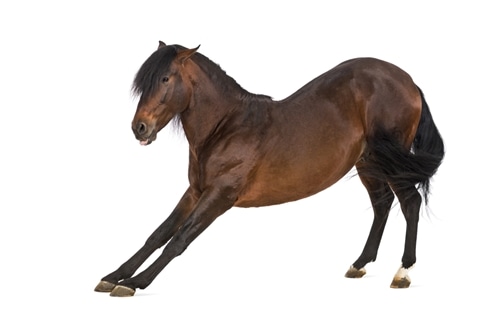For years, breakthroughs in medical technology have helped save lives. Better wiring and internal structures have improved the capabilities of devices like pulse oximeters and portable defibrillators, while newly enhanced techniques let physicians better treat diabetes, cancer and other diseases. Now, horses are reaping similar benefits, as a research group out of Canada has developed a new health monitoring device exclusively for horses, according to Horsetalk.Breaking technological ground
The SeeHorse is comparable to the wristbands people wear at the gym to monitor their vital signs. Strapping onto the horses’ bridle, the device monitors their pulse, temperature and respiratory functions, compiling a daily report that’s accessible through a smartphone app. Breeders, trainers and vets alike can then monitor these reports, or they can be emailed instantly if any one of these numbers changes drastically. This already has helped several test horses avoid potential long-term damage.
“We saw a horse’s temperature spike and then drop unexpectedly and it took only seconds to notify the owner, the veterinarian and others about the event,” said SeeHorse co-developer Peter Mankowski, also known for his work with communications manufacturer BlackBerry, told Horsetalk. “Thankfully, it was not an emergency but simply the case of the horse having early pregnancy signs.”
Additionally, people can link the SeeHorse app to their Facebook or Twitter profile, allowing them to share details of their horses’ health to followers and friends.
Not only is this a promising life-saving tool, but there’s a number of other benefits from the SeeHorse. Mankowski told Horsetalk that the SeeHorse is also a “coach-veterinary tool,” allowing people to learn about horse anatomy and health maintenance through a real-time monitoring system. The device is also attached through special waterproof straps that recharge the internal battery through the horses’ actual movement. Thus, the SeeHorse has no discernible environmental footprint.
SeeHorse is still in development, though sales are expected to begin in September 2015.
Standard horse diagnostics
SeeHorse co-founder Jessica Roberts told The Record that the device does its best to diagnose horses through their own natural expression of symptoms. For instance, colic, an umbrella term for a number of gastrointestinal conditions, has a distinct physical manifestation.
“A way that horses try to relieve the discomfort of colic is to get up and down and roll,” Roberts told The Record. “SeeHorse can tell you if your horse has been up and down five times in the last two minutes, and you are going: ‘OK, that’s not normal at all.'”
Though using such clues seems obvious, it’s a noticeable improvement on past methods of diagnosis. Many diseases and ailments in horses are hard to uncover in the first place. Lameness within horses can have a number of different causes, from pulled muscles and fundamental behavior issues to more serious issues like nerve or bone damage.
Other diseases are just as difficult to pin down. Speaking to TheHorse.com, Julie Fjeldborg, associate animal studies professor at the University of Copenhagen, said there are 100-plus causes for dysphagia, or the inability to swallow. Even something like equine protozoal myeloencephalitis, an infection that causes muscle weakness, can mimic other neurological disorders, thus complicating the overall diagnosing process.
Often times, effectively treating a horse comes down to actual timing. Take, for instance, botulism, a neurological disorder caused by exposure to harmful toxins. According to a study published in the Journal of Veterinary Internal Medicine, 48 percent of horses admitted to the hospital survived. The key to that rate, according to researchers, was paying attention to early warning signs and acting accordingly.
Prevention is key
There’s no way to ever entirely prevent a horse from becoming ill. However, as a breeder or trainer, there are steps that can be taken to help horses fight off disease, namely supplements. Fluid Action® HA Liquid contains various vitamins and supplements that help promote healthy bones and joints. The biotin found within Horse-Shoe™ can help promote healthy hoof growth. Finally, U-7™ Gastric Aid uses ingredients like cinnamon and licorice to promote a healthy appetite and digestive function.









